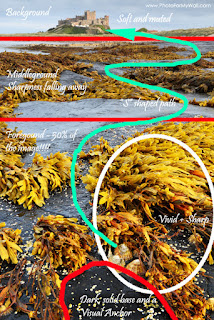People often ask photographers if they Post Process (that is, use a computer to alter their images). I find this a bit of a nonsense question - if you use a digital camera, you are using ac omputer to see an image. Nowadays the computer does the same as the lab did in the days of film ie it takes the negative (your RAW file) and turns it into a print (or a digital image to look at on a computer -usually a jpg). Even if you don't use a computer the camera turns its code into a jpg and makes choices on your behalf about contrast and saturation etc. So, we all post process, consciously or unconsciously. The question should really be "How much do you post process?". Personally my answer is that I take out movable objects (like litter and cars) but not immovable objects (like trees and buildings). Everything else I do, are simple developing decisions that mirror a traditional chemical lab darkroom. My PC is my darkroom.
Now, the blog post... HOW do you post process?
Which is a difficult question
to answer with a mouthful of bacon and brie ciabatta. Every now and then I have
lunch with a togging pal (we'll call him David, as that's his name) and we
shoot the breeze on just about every aspect of photography you can think of.
 Today's lunch , aside from being very tasty, covered film photography, shooting
with instamatics to gauge your non digital skill levels, reprocity failure,
chromatic aberration (the purple fringey things) and the value of motion blur
in dynamic images. Oh yes, and how to digitally enhance dog fur. Interesting
and varied chats we have.
Today's lunch , aside from being very tasty, covered film photography, shooting
with instamatics to gauge your non digital skill levels, reprocity failure,
chromatic aberration (the purple fringey things) and the value of motion blur
in dynamic images. Oh yes, and how to digitally enhance dog fur. Interesting
and varied chats we have.
Then David, who is a purist, but is starting to grasp the
Lightroom nettle, asked about my (is it really?) 8 years of Photoshop
experience. He asked how to process images. Talk about an open question! But at
that point I was being careful not to spill gorgonzola and broccoli soup down
my front and replied in a fairly non committal manner - a sort of soup filtered
grunt. But it's a good question and post ciabatta and soup and post my day job
office hours, I've had time to consider. And the answer is another question (or
at least starts that way). The real question is "WHY do you post
process" - only by asking that, can you decide HOW you will do it.
Landscapes are my passion (David likes to photograph
lumps of metal birling round a wee road, I don't really know why) so I'll tell
you why I typically post process a scenic image. Simply, I want to give the 2
dimensional image the same 3 dimensional feeling that I got when I took it.
This means it needs something that a print or screen can't give - depth. I need
to optically provide the depth of miles on a canvas that's microns thick. I've
drawn a wee diagram to illustrate how ( I like diagrams even more than bacon
and brie - I guess I'm a visual learner).
I trained as a designer, so have had a tiny grounding in
painting and drawing, which comes in very handy here. One of the things that
you learn when you paint is that close items have very different properties to
distant objects. First off, they are more vibrant, clearer and with more
contrast. Now that doesn't mean you should go nuts and over saturate the
foreground, but a subtle effect is to raise the saturation a little and then
concentrate on the background which you can mute a little, maybe even let it fall out of focus a bit. Overall you get a
subtle, but effective, feeling of depth..
 Here's an example (finished image at the bottom of this post) - click on it to see it larger, but the explanation is... really sharp, colourful high contrast limpits and seaweed (yes it actually was that colour - I haven't exaggerated it), an interesting fairly sharp but muted middle-ground and a softer less contrasty background that happens to be quite interesting too (so the viewer looks from front to back. You might notice that I even ensured there was a "visual path" from limpits to castle, using the contrast between sea weed and dark grey rock) - lots of depth! Note that the sharpness and it's "fall off " were achieved "in-camera", but it would be just as easy (easier?) to do this in post processing. To improve the picture it needs some emotion or a story too, but unfortunately there was no ravenous seagull handy that I could persuade to engage in a life or death struggle with the limpits. I guess lapping water may have been a more mundane "story" though.
Here's an example (finished image at the bottom of this post) - click on it to see it larger, but the explanation is... really sharp, colourful high contrast limpits and seaweed (yes it actually was that colour - I haven't exaggerated it), an interesting fairly sharp but muted middle-ground and a softer less contrasty background that happens to be quite interesting too (so the viewer looks from front to back. You might notice that I even ensured there was a "visual path" from limpits to castle, using the contrast between sea weed and dark grey rock) - lots of depth! Note that the sharpness and it's "fall off " were achieved "in-camera", but it would be just as easy (easier?) to do this in post processing. To improve the picture it needs some emotion or a story too, but unfortunately there was no ravenous seagull handy that I could persuade to engage in a life or death struggle with the limpits. I guess lapping water may have been a more mundane "story" though.
I'll not get too technical here but the basics are as follows - if you need advice, feel free to mail me at PhotoForMyWall@gmail.com.
To locally change the saturation, you can mask the rest of the
image and boost saturation, or select the bit you want and saturate it. Or
increase vibrance. Or lift the exposure and increase the contrast a bit.
Combine this with a few other wee tricks and your landscapes can really start
to pop! The point is though, that there are many ways to increase depth, and
within Photoshop there are a gazillion ways of doing any particular effect. So
"how do you Photoshop?". Well decide what you want to do, look up You
Tube, read Scott Kelby's books, ask friends, there are many ways. But answer
that first question quickly, "why process?", ...before the soup goes
cold.



No comments:
Post a Comment